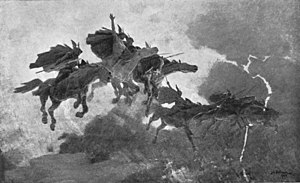Valkyries
Valkyries
You can win the battle you face. Let go of your inner restrictions and others' expectations. Explore your wild self. Redemption is always available. Be the hero in your own life.
Through the blood and the screaming,
I ride searching.
Sweat, tears, my horse rearing,
I see you.
Brave, dying,
Your hand still upon your sword,
Pain creasing your face.
You see me,
And all changes,
A soft smile of redemption and recognition.
I am Valkyrie!
Some say that near death our whole life flashes before our eyes. But according to the Norse mythology, what flashed before the eyes of the Viking warriors as they lay dying upon the battlefield was a beautiful, yet terrible, woman flying on a mighty horse, eyes blazing, singing a song of blood and glory.
The Valkyries were known variously as "choosers of the slain", "battlefield maidens", "mead maidens" and "shield maidens". They selected the bravest, most worthy of dead warriors - called the einherjar - and spirited them either to Valhalla to spend the afterlife with Odin or to Fólkvangr to reside with Freyja. There, the Valkyries would serve the einherjar mead until they rallied beside the gods for their final battle, Ragnarok.
Some sources suggest Freyja as the mistress of the Valkyries, naming her "Valfreyja", "mistress of the slain". Just as the einherjar are considered the foster sons of Odin, the Valkyries are the beloved foster daughters of Freyja. Appropriately, they worked primarily with and under her magic. Freyja also took those women who in life followed her witchcraft most fervently or who were themselves taken in battle to be Valkyries.
Valkyries appeared in the Völsunga saga, in the Eddas and many other places in Norse mythology, and have widely influenced Norse art and music.
For instance, in the Old Norse poem from the Poetic Edda "Helgakviða Hundingsbana I", we read this:
Then light shone from Logafell,
and from that radiance there came bolts of lightening;
wearing helmets at Miningvani came the Valkyries.
Their byrnies were drenched in blood,
and rays shone from their spears.
And Richard Wagner's "Ride of the Valkyries", an excerpt from his opera "Die Walküre" (The Valkyrie), found popular appreciation after it was used to score a memorable helicopter scene in the movie Apocalypse Now.
Early depictions described the Valkyries as Odin's Ravens - black and terrible, screaming their way across the skies on wild horses and dripping in blood. In later texts, however, they were shown as more beautiful and benevolent, while still retaining their power.
Valkyrie energy is wild, yet offers both redemption and relief from the weariness of battle. Most modern readers do not find themselves in true combat situations, but our lives may still feel like a daily battle. Through their example of power and wildness, the Valkyries urge us to exhibit courage in our daily lives and release ourselves from the bonds of regret.
----------------------------------
----------------------------------
Valkyrie
(Redirected from Valkyries)
In Norse mythology, a valkyrie (/vælˈkɪəri,
Valkyries are attested in the Poetic Edda (a book of poems compiled in the 13th century from earlier traditional sources), the Prose Edda, the Heimskringla (both by Snorri Sturluson) and the Njáls saga (one of the Sagas of Icelanders), all written—or compiled—in the 13th century. They appear throughout the poetry of skalds, in a 14th-century charm, and in various runic inscriptions.
The Old English cognate terms wælcyrge and wælcyrie appear in several Old English manuscripts, and scholars have explored whether the terms appear in Old English by way of Norse influence, or reflect a tradition also native among the Anglo-Saxon pagans. Scholarly theories have been proposed about the relation between the valkyries, the Norns, and the dísir, all of which are supernatural figures associated with fate. Archaeological excavations throughout Scandinavia have uncovered amulets theorized as depicting valkyries. In modern culture, valkyries have been the subject of works of art, musical works, comic books, video games and poetry.




Comments
Post a Comment